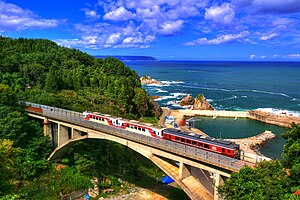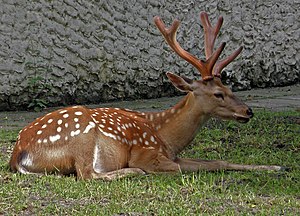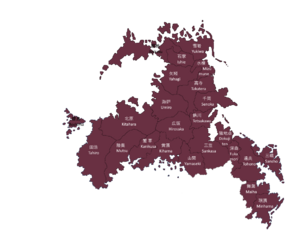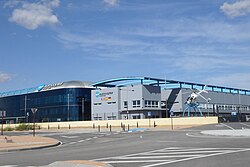Hakuryou
Hakuryan Realm 白令予国 (Nifonese) Hakureiyo-koku | |
|---|---|
| Anthem: 愛国 の 歌 (Aikoku no Uta) Song of the Beloved Country | |
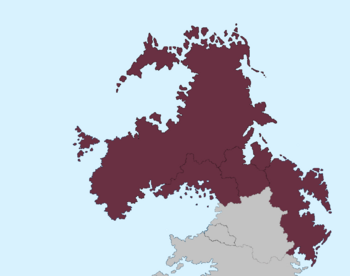 Hakuryou's location in TBD | |
| Capital and largest city | Yukyo |
| Recognised national languages | Nifonese |
| Ethnic groups (2019) | 93.3% Kano Hakuryan, 6.7% other |
| Religion | Shintoism |
| Demonym(s) | Hakuryan |
| Government | Unitary parliamentary constitutional monarchy |
| Harukazu | |
• Shogun | Gosankyo Daichi |
| Nakamura Takeru | |
| Legislature | Imperial General Court |
| Court of Council | |
| Popular Court | |
| Formation | |
• Landing of the Hakuryou | 1547 |
• Establishment of the Hakuryan Imperial dynasty | 1577 |
• Yukyo Concord | 1888 |
• Current constitution | 1953 |
| Population | |
• 2022 estimate | 89,124,155 |
• 2019 census | 88,342,100 |
| GDP (PPP) | 2022 estimate |
• Total | 2.3 trillion |
• Per capita | 25,807 |
| GDP (nominal) | estimate |
• Total | 2.1 trillion |
• Per capita | 23,563 |
| Gini (2022) | high |
| HDI (2016) | high (high) |
| Currency | Hakuryan mon 文 (HKM) |
| Time zone | TBD |
| Date format | dd-mm-yyyy |
| Driving side | left |
| Calling code | +88 |
| Internet TLD | .hku |
Hakuryou (Nifonese: 白令予, Hakureiyo, officially the Hakuryan Realm (Nifonese:白令予国, Hakureiyo-koku), is a nation located in Northern Shintochi. Hakuryou is bordered by Gopla and Daniel-Franklin to the south. Hakuryou is composed of TBD subdivisions.
Hakuryou was first inhabited by TBD tribal groups in various areas during the Mesolithic area. Nifonese explorers had made landfall on the island as early as 1502, but large-scale colonization attempts were not made until the end of the Sonjo War, when parties disaffected or disgraced in the war's aftermath including many prominent pagan clans fled Nifon rather than suffer persecution. The first such group carrying these nobles landed in what would eventually become the city of Ichiminato in 1547. Arriving clans settled various parcels of land, primarily on the southern peninsula which was ripe with farmland. Immediate contests regarding land use lead to the War of Three Summers initiating in 1574. It was concluded when the Hakuryan Imperial Dynasty was first established and legitimized in 1577, with the first Emperor claiming lineage from most of the major Hakuryan clans at the time. The Emperor acted with increasing reach over domestic affairs, culminating in the Sakomoto Revolt of 1770. A seven year war ensued and culminated in the defeat of Imperial forces by a combined Takamura-Gosankyo army at the Battle of Kasumigaoka, resulting in a shogunate system with Imperial power reduced to a figurehead role and real power resting in what would be known as the Five Regent Houses. Eulabian ideals and technology reaching Hakuryou throughout the 19th century and increasing unpopularity of the totalitarian Shogunate government lead to the Shiroihata War from 1885 to 1888, which was resolved by the signing of the Yukyo Concord, in which the shogunate ceded a number of powers to a popular government and accepted the imposition of a constitution. Mutual focus on rapid rebuilding from the effects of the war lead to rapid industrialization, bolstered by the threat of Nifon doing the same. While it emerged unscathed from the First Great War, its second saw its expansions against Nifon blunted. A focus on commercial activity and significant economic growth after the Second Great War saw Hakuryou emerge as a middle power.
Hakuryou is nominally a unitary parliamentary constitutional republic, however the Emperor is extremely reclusive and exercises little direct power. Executive power is vested in the Shogunate, a non-elected position that is staffed by qualified nobility from the Five Regent Houses. This is kept in balance by an elected civilian government, lead by the Principal Minister who is selected from the parliament. Generally, the Shogun is responsible for the overall leadership of the country and in particular its foreign affairs, while the civilian government exercises a large amount of domestic political influence including the maintenance of most public ministries. Hakuryou consists of ## subdivisions. Hakuryou is heavily urbanized, with approximately 67% of its population living in large urban centers. Its capital is Yukyo.
Etymology
The name of Hakuryou is written using the kanji 白令予 and is pronounced Hakureiyo, the meaning of which is generally translated to esteemed white order. Historians generally recognize the name as one belonging to the flagship of an exodus fleet from Nifon in the aftermath of the Sonjo Wars, however the ownership or leadership of this fleet remains a hotly debated topic. Wood from the ship was symbolically used by its passengers in the construction of the port of Ichiminato, with its nameplate incorporated into a decorative gable parting the port from the city proper. Ichiminato was briefly referred to as Hakureiyomachi (白令予街, literally Town of Hakureiyo) before being redubbed as Ichiminato. The nameplate of the ship has been preserved in the Imperial Ichiminato Museum of National History, and replicas of the nameplate are posted at ports of entry across Hakuryou.
History
Main article: History of Hakuryou
Early history and initial exploration
Hakuryou was first inhabited by humans during the Mesolithic era, who likely emigrated over land bridges present at the time. These groups primarily lived in dug-out shelters and occupied Shintochi's western side north of the Mutsu River. Over time, these groups developed agriculture growing rice, fruits and vegetables, and established primitive farming communities. Around 1300 BCE, these groups developed into an increasingly coordinated civilization that conducted large scale agriculture and built with stone, known as the Ishizo People (石造 Ishizo, lit. Stone Creators). The Ishizo culture straddled the Seimeiharu mountain foothills and forests, and settlements existed as far south as the northern bank of the Mutsu River. Ishizo society collapsed around 200 AD for unknown reasons- they did not keep a written language, and oral records of their time are scant. Archaeologists investigating the time period when the Ishizo collapse occurred have found no conclusive or widespread evidence as to any one cause, and their collapse remains a mystery to this day. The modern Hakuryan Aborigines (原住民 genjūmin) are largely descended from Ishizo stock and share significant genetic similarities.
The identity of the first Nifonese to discover and explore Shintochi is widely debated, however most historians agree that initial attempts began in 1502. With little interest and support from mainland Nifon in exploratory efforts, most early attempts were limited in scope or repulsed by native tribes. No permanent settlements were ever established, as there was little financial impetus nor logistical capability to support such ventures. Tsuge Mitsuoki is generally credited as the first explorer to succesfully make contact with the genjumin and become aware of the Ishizo culture in 1522. Tales of the Ishizo and the people of Shintochi did reach back to Nifon, however interest was limited. Nifon, at the time, was embroiled in a series of military contacts that would later climax in the Sonjo Wars that would be a direct cause of subsequent colonization.
The Sonjo Wars saw the decisive defeat of the Suda clan and its allies and their uprootment from positions of power in Nifon. Fearing persecution, Suda and a number of disaffected clans fled their ancestral homes in Nifon to re-establish their positions in Shintochi. An enormous exodus fleet landed on the western shores of western Shintochi, spearheaded by the landing of the war umikan Hakureiyou.
Landing of the Hakureiyou and imperial consolidation
The records of the exodus' landing on the shores of what is now TBD Province was collected by Tamase Isai, the daughter of the lord Tamase Ichiro, who was a fudai retainer of Clan Sakamoto, in a collection of stories later known as the Shintochi Shoki (新土地書紀, Shintochi Chronicle). The Hakureiyou landed sometime in the late summer 1547 along with a fleet of an estimated 100 ships. The ships were dismantled and repurposed into the initial buildings and walls of the town of Hakureiyomachi, later renamed Ichiminato. While the major noble clans- among them the Suda and Gosankyo, who had traveled with significant forces of military retainers and samurai- attempted to establish domains, their forces and available resources were completely insufficient in establishing control similarly to what they had once had in Nifon proper. Lawlessness rapidly became the norm in the countryside as self-made lords were proclaimed in multiple settlements, who rapidly came into conflict with both the established noble houses and others in their surroundings regarding land claims and provocations. This culminated in the War of Three Summers initiating in 1574 and the devolvement of Hakuryou into warlord states and rampant warfare. This was only halted when most of the major houses threw their support behind Emperor Saiten, the first of the Hakuryan Imperial Dynasty. Sources on Saiten and his origin specifically are scant- most cite that he had backing both by religious factions and a favorable bloodline. Hakuryou was unified under his rule as a feudal state in 1577, concluding the war in an Uti possidetis state.
Imperial Era
Emperor Saiten spent much of his reign establishing a lasting peace and building a stable, functioning framework in his 31 years of rule. Dying in 1598, his successor, Shoken, worked heavily on stabilizing the state Saiten had built, encouraging infrastructure, art cultivation, and architectural projects across Hakuryou. Under his rule, the first ventures across the western side of the Seimeiharu mountains occurred and the settling of what would later become Yukiwa and Mizumune Provinces. Some conflicts did occur during this period, but most were settled quickly under mediation. By the mid 1600s, most of Hakuryou north of the Satsukimori Forests area was inhabited along settled family lines. Intrusions south were limited by a lack of resources and the resistance of Goplish groups to the forest's south. Emperor Bunkei led a succesful war in 1654 to dislodge Goplish groups from areas that now comprise the southern portions of Yamaseki and Sankasa Provinces, and his successor, Kouka, expanded Hakuryou to control the entirety of Fukamori and Donkujiten Provinces in 1672.
These two wars, colluqially known as the Southern Expansion Wars (南部拡大戦乱, nanbu kakudai senran), were the impetus for a gradual change of power consolidation that took place through the later parts of the 17th and early 18th centuries. While some historians note that Bunkei did enact reforms that were generally in line with the idea of power consolidation, most note that Kouka was the first to take deliberate steps towards this end, including tax and land reforms, and the first implementation of an Imperial bureaucracy dedicated to managing and executing these roles. Successive emperors made steps to centralize powermaking and decision-making authority in their own hands, through measures such as requiring Imperial confirmation of heirs or inheritance and expanding tax burdens on subordinate lords to maintain spending originally sourced for the wars. This came to a head during the rule of Emperor Jimsei, who introduced a number of extremely controversial reforms, including land distribution and reforming Imperial law to enforce an absolute primogeniture system of inheritance rather than male primogeniture as was the norm prior- mainly a maneuver to further weaken the clans in the immediate future and consolidate his power. This led to immense discontent within the major daimyo clans, and the breakdown of negotiations amidst further rulings made by Jimsei resulted in a number of clans revolting against Imperial rule in 1770.
Sakamoto Revolt and establishment of the Shogunate
In 1770, a number of minor clans-who were directly backed by Gosankyo and, to a lesser extent, Takamura clans- announced that they would no longer recognize Emperor Jimsei's rule as legitimate and would ignore his mandates. Initially consisting of skirmishes in an attempt to limit the emergence of a wide-scale war in Hakuryan territory, attempts to downplay failed rapidly and emerged into a widespread war consisting of three camps- the Imperials, the Sedaimyos (背大名, 'rebel lords'), and those clans attempting to maintain neutrality. Following a disastrous defeat of Imperial forces in 1773 at the Battle of Kagamiyama, an attempt at a mediated peace was made by Clan Sakamoto, who had consulted with the other Sedaimyo clans on peace terms, and invited the Imperial clan into their seat at the foot of the Seimeiharu mountains. Emperor Jimsei emerged from the negotiations with Clan Sakamoto having been slaughtered to a man and their keep burned as a measure of intimidation, an act that drove most of the neutral clans into the Sedaimyo camp and reignited the war on a massive scale. The war later took on the name of the Sakamoto Revolt in their name. The war raged for another four years before Imperial forces were defeated decisively by a Takamura-Gosankyo army at the Battle of Kasumigaoka, and the captured Jimsei was forced to capitulate. The Sedaimyos forced him to write a constitution that, while granting the Imperial Family the right to exist as a figurehead as it had in Nifon, relinquished virtually all of its powers to the Sedaimyos to rule in council, with their head and the Emperor's representative taking form in the position of Shogun, a more restrictive version of the agreement the Sakamoto clan had presented years ago. The position of Shogun was restricted to the head daimyos- the founding clans of Suda, Gosankyo, Takamura, Shirogawa, and the newly-elevated Shinonono clan, and feudal and imperial structures were retained for the most part.
Eulabian Enlightenment period
In the aftermath of the Sakamoto Revolt, the newly-established Shogunate retained much of the oversight and infrastructure that had been allowed to the Imperial house, with the Emperor succeeding Jimsei- Emperor Kaiso- working succesfully as a mediator over disputes between the ruling clans alongside the Shogun himself. In an effort to stimulate commercial activity within the country to accelerate rebuilding and lessen tensions, the Shogunate opened up to mostly unrestricted trade with the outside world, taking income from the taxes gathered to assist in shoring their own stability and enhancing domestic Hakuryan prospects.
The opening of the country introduced Hakuryou to a number of foreign products and ideas, which trickled into the country through the late 18th century into the 19th. Social circles began to grow endorsing some Eulabian idealisms such as rule of law and democratic process, as witnessed by other nations enacting such positions across the world. The Shogunate increasingly began to restrict divisive political activity, while retaining the broadly authoritarian government system it had inherited from the Imperial era. A series of famines from 1879 through 1874 and strict control of food resources saw popular sentiment against the Shogunate turn severely, and in 1885, rebels under the leadership of Nakamura Ichiro rose in revolt in the name of the Emperor, aiming to restore him to rule, and earned the support of a number of fudai vassals and large swathes of primarily skilled common-class tradesworkers and merchants rose up to overthrow the Shogunate. Named for the white crane-emblazoned banners that made their banner, the Shiroihata War lasted from 1885 to 1888 and was fought to a bitter standstill. In late 1886, the rebel faction, denied support by the Emperor, changed their aims to the overthrow of both parties and the institution of a republic. Although the populist faction had a large numerical superiority, their military command was extremely disjointed and began to be defeated in detail by Shogunate forces. The immense casualties suffered at the Siege of Miyashiro by both sides brought them to the negotiating table. The Shogunate ceded many of its powers, primarily in the form of national taxation and the widescale reduction of the authority of their domains to civilian authorities, in exchange for retaining both a small independent military force and primacy of executive power, kept in check by a civilian government. A constitution was established, and, in 1889, Hakuryou elected its first civilian government.
Early Modern period and Great War 1
>Mutual focus on rapid rebuilding from the effects of the war lead to rapid industrialization, bolstered by the threat of Nifon doing the same.
Great War 2
Skirmishes with Nifon that are lost, ousting of clan shirogawa after attempts to suppress popular protest
Post-war and modern day
Geography
Main article: Geography of Hakuryou
Hakuryou occupies the northern portion of Shintochi, which is straddled by the Seimeiharu Mountains that run from north to south along the island's western side. The Seimeiharu is the source of many of the nation's large rivers that run into the Furukan and Libre oceans which border it to the west and east respectively. Geographers generally seperate Hakryou into 6 separate geographic localities: The Mutsu Basin, the Eastern Coast, the Central Foothills, Seimeiharu Mountains, Satsukimori Woodlands, and the Western Coast. The Mutsu Basin, consisting of land irrigated by the Mutsu River and its tributaries, are considerably fertile and flat and widely used for farmland, and the Eastern Coast is also used for farming as well. The Seimeiharu Mountains are a relatively uniform set of peaks, with its highest point being Mount Fubuki at TBD meters high. The Satsukimori Woodlands are a relatively uninhabited stretch of woodlands on the Goplan and Daniel-Frankliner borders, and the Eastern Coast while relatively flat compared to nearby foothills are only suitable for industry and mining due to a lack of fertile soil.
Climate
Main article: Climate of Hakuryou
Hakuryou has a varied climate, which is generally humid subtropics in the south and continental temperate in the northern third of the country. The northern and central regions of the country regularly recieve snowfall during the winter with the southern and southern central regions generally experiencing colder but rainy summers. Wet seasons generally last from June through August. The average temperature during the summer is 26 degrees celsius, with the average during winter being 4.5 degrees.
Biodiversity
Main article: Climate of Hakuryou
The position of Hakuryou in northern Shintochi has cultivated flora and fauna that are hardy and resistant to temperature changes, and include species native to the land and ones introduced both from Nifon and elsewhere abroad.
Wildlife
Main article: Climate of Hakuryou
Politics
Main article: Politics of Hakuryou
-Lead by the Hakuryan National Party -Dominant politically, lasseiz-faire socially, think CCP -Elections are held for party officials but leadership is elected from a 'qualified' candidate pool nationally -Most other parties that do not subscribe to the National Party's ideology of Hakuryan Social Nationalism or some variant of it are banned
Government
Main article: Government of Hakuryou

Hakuryou is a unitary dominant-party directorial republic, following a form of government unique and intrinsic to it. Guidance and framework for the government is established in the Constituting Article of the Miscatean Social Union, which serves to outline and define the organs of state. It enshrines the Hakuryan National Party as the 'custodian of the Hakuryan nation and people', and largely omits many previously guaranteed personal rights under prior governments.
Executive power is nominally vested in the Council of Directors, a pool that generally consists of eight to twelve individuals who jointly execute executive powers, and are elected within the party from qualified individuals. However, since 1975, executive power generally rests in the Chief Director who is selected by the other Directors to administrate the state. In practice, the Council of Directors is more akin to a cabinet in other executives, and the Chief Director, who generally also serves as the chairman of the National Party, has a wide hand to direct policy and legislation. The President also serves as the commander-in-chief of the Armed Forces.
The legislature, known as the Congressional Assembly (Assemblée en Congrès), is a unicameral assembly consisting of 502 elected delegates representing constituent areas of Hakuryou. The National Assembly is directly elected in a two-round election to represent constituencies of roughly 100,000 people from qualified members of the National Party.
Judiciary and law enforcement
Main article: Judicial system of Hakuryou, Law enforcement in Hakuryou
Hakuryou's judicial systems derive from Arlesian laws and follows a civil legal system. The basic tenets of Miscatian law were formally codified under Achillean Code, which forms the basis of many modern western legal systems- the code itself derives from statues of royal law established over centuries prior. Famed jurist Grégoire Lachapelle, the first Chief Arbiter of the Supreme Court, wrote that laws "should be made to serve the common interest wholly, to the extent it begins to detract from the common man's interests severely." That is, laws should serve to protect the interests both of the general population and the rights of the individual without infringing upon either too egregiously.
Hakuryan law is subdivided into civil, or common laws (loi commune) and public laws (loi publique). Courts are organized at the regional and departmental levels. Hakuryou has three courts of last resort with differing jurisdiction- the Court of Cassation with jurisdiction over civil and criminal matters, the Supreme Constitutional Court with review of constitutional cases, and the State Council with overview of administrative cases.
Hakuryou has a strong tradition of secularism in government following the days of the Miscatian Republic's rampant secularization of the entirety of the social apparatus. Monarchs of the House Roumarin have adopted deist belief systems since their installment and have rooted much of the religious traditions out from royal affairs. Hakuryou does not accept religious canon laws as valid legal statutes. Hakuryou has not recognized laws for blasphemism and laws for sodomy since the late 1700s, however, many laws which found origin in religious bylaws have found places in public law, including public indecency and disturbance of public order statutes. Hakuryou has allowed for freedom of religion and religious expression since the Republic, but constitutionally requires that religious laws are subordinate to national laws and requirements. This has resulted in some controversies, most notably the 2006 ban on !Islamic veil wearing in public.
Administrative divisions
Main article: Regions of Hakuryou, Departments of Hakuryou, Local administrative units in Hakuryou
Hakuryou is organed into 24 subdivisions known as provinces, which consist of ## regions in metropolitan or continental Hakuryou, and ## overseas regions. These are further divided into departments, who in turn are divided into arrondisments, communes, and cantons, which serve varying administrative and legal purposes.
Foreign relations
Main articles: Foreign relations of Hakuryou
Military
Main article: Hakuryan Armed Forces
The Hakuryan Armed Forces (Forces Armées Hakuryan) is the armed forces of the Miscatian Union and consist of 5 branches- the Army (Armée de Terre), the Navy (Marine), the Air and Space Forces (Armée de l'Air et l'Espace), the Strategic Forces (Forces Stratégiques), and the Gendarmerie.
Economy
Main article: Economy of Hakuryou
Industry
Services and tourism
Agriculture and fishery
Science and technology
Main article: Science and technology in Hakuryou
Infrastructure
Transportation
Main article: Transport in Hakuryou
-lots of rails -extensive investment in infrastructure -most infrastructure state owned
Energy
Main article: Energy in Hakuryou -major nuclear energy proponent
Demographics
Main article: Demographics in Hakuryou
Template:Largest cities of Hakuryou
Language
Main articles: Languages in Hakuryou
hon hon
Religion
Main articles: Religion in Hakuryou
State deism, religious generally not restricted other than 'deviant religions' (exclusively at choice of gov't
Education
Main article: Education in Hakuryou -College is free to those who qualify for it
Health
Main article: Healthcare in Hakuryou -national healthcare system
Culture
Main article: Hakuryan culture



